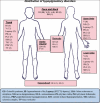Hypopigmentary disorders in children in South India
- PMID: 22121275
- PMCID: PMC3221220
- DOI: 10.4103/0019-5154.87152
Hypopigmentary disorders in children in South India
Abstract
Background: Hypopigmentary disorders are common group of dermatoses in pediatric age group.
Aim: To study the frequency and patterns of hypopigmentary disorders in children.
Materials and methods: This study was a descriptive clinical study spanning over a period of 23 months. A total of 113 children (61 boys and 52 girls) were included in this study.
Results: The frequency of hypopigmentary disorders among children was 3.28 per 1000 children attending the dermatology out patient department. The mean age of the children was 7.2 years. The mean of age of onset was 7.36 years. Most common hypopigmentary disorder in our study was pityriasis alba (24.7%), followed by vitiligo (20.4%), leprosy (11.5%), nevus depigmentosus (10.18%), and tinea versicolor (6.2%). Others were hypomelanosis of Ito (5), post-inflammatory hypopigmentation (5), pityriasis rosea (4), steroid-induced hypopigmentation (4), lichen sclerosus et atrophicus (3), pityriasis lichenoides chronica (3), lichen striatus (2), oculocutaneous albinism (2), tuberous sclerosis complex (2), pigmentary mosaicism (1), and Griscelli syndrome (1).
Conclusion: Pityriasis alba, vitiligo, leprosy, nevus depigmentosus and tinea versicolor are the five most common hypopigmentary disorders in children.
Keywords: Hypopigmentary disorders; leprosy; nevus depigmentosus; pityriasis alba; tinea versicolor; vitiligo.
Conflict of interest statement
Figures
Similar articles
-
Disorders of hypopigmentation in children.Pediatr Clin North Am. 1991 Aug;38(4):991-1017. doi: 10.1016/s0031-3955(16)38164-0. Pediatr Clin North Am. 1991. PMID: 1870914 Review.
-
Clinicopathological correlation of acquired hypopigmentary disorders.Indian J Dermatol Venereol Leprol. 2013 May-Jun;79(3):376-82. doi: 10.4103/0378-6323.110800. Indian J Dermatol Venereol Leprol. 2013. PMID: 23619442 Review.
-
Evaluation of diagnostic accuracy of dermoscopy in some common hypopigmented skin diseases.Arch Dermatol Res. 2024 Aug 23;316(8):562. doi: 10.1007/s00403-024-03259-8. Arch Dermatol Res. 2024. PMID: 39177715
-
Nevus depigmentosus: the analysis of 37 cases.Ital J Dermatol Venerol. 2021 Feb;156(1):62-67. doi: 10.23736/S2784-8671.20.06681-X. Epub 2020 Nov 23. Ital J Dermatol Venerol. 2021. PMID: 33228333
-
Dermoscopy in General Dermatology: A Practical Overview.Dermatol Ther (Heidelb). 2016 Dec;6(4):471-507. doi: 10.1007/s13555-016-0141-6. Epub 2016 Sep 9. Dermatol Ther (Heidelb). 2016. PMID: 27613297 Free PMC article. Review.
Cited by
-
Asymmetric Bilateral Lichen Striatus: A Rare Presentation following Multiple Blaschko's Lines.Case Rep Dermatol Med. 2018 Jun 10;2018:6905175. doi: 10.1155/2018/6905175. eCollection 2018. Case Rep Dermatol Med. 2018. PMID: 29984008 Free PMC article.
-
An Indian boy with griscelli syndrome type 2: case report and review of literature.Indian J Dermatol. 2014 Jul;59(4):394-7. doi: 10.4103/0019-5154.135494. Indian J Dermatol. 2014. PMID: 25071262 Free PMC article.
-
Usage of Dermoscopy as an Effective Diagnostic Tool in Pityriasis Alba: A Prospective Observational Study Among Children in a Suburban Hospital in South India.Cureus. 2023 Jun 11;15(6):e40271. doi: 10.7759/cureus.40271. eCollection 2023 Jun. Cureus. 2023. PMID: 37448397 Free PMC article.
-
A concise approach to childhood hypopigmentation.J Cutan Aesthet Surg. 2013 Apr;6(2):73-4. J Cutan Aesthet Surg. 2013. PMID: 24023427 Free PMC article. No abstract available.
-
Clinical epidemiological profile of vitiligo in children and adolescents.An Bras Dermatol. 2013 Nov-Dec;88(6):1026-8. doi: 10.1590/abd1806-4841.20132219. An Bras Dermatol. 2013. PMID: 24474125 Free PMC article.
References
-
- Toossi P, Nabai L, Alaee Z, Ahmadi H, Saatee S. Prevalence of skin diseases and cutaneous manifestations among Iranian children.A survey of 1417 children. Arch Dermatol. 2007;143:115–6. - PubMed
-
- Pinto FJ, Bolognia JL. Disorders of hypopigmentation in children. Pediatr Clin North Am. 1991;38:991–1017. - PubMed
-
- Vinod S, Singh G, Dash K, Grover S. Clinico-epidemiological study of pityriasis alba. Indian J Dermatol Venereol Leprol. 2002;68:338–40. - PubMed
-
- Jaisankar TJ, Baruah MC, Garg BR. Vitiligo in children. Int J Dermatol. 1992;31:621–3. - PubMed
-
- Kumar B, Rani R, Kaur I. Childhood leprosy in Chandigarh: clinicohistopathological correlation. Int J Leprol. 2000;68:330–1. - PubMed
LinkOut - more resources
Full Text Sources
Other Literature Sources
Medical
Molecular Biology Databases
Miscellaneous

